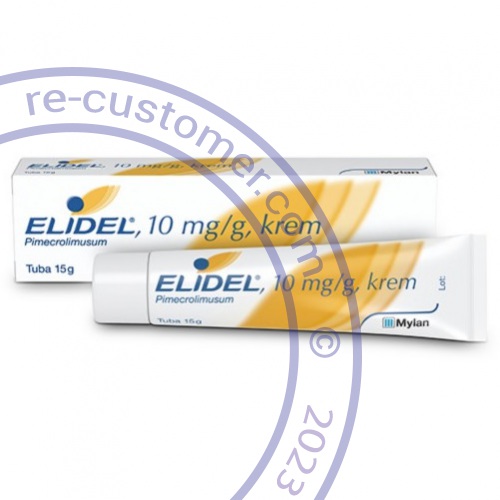- Trusted Tablets
- Skin Care
- Elidel

Brand(s): Elydel
Manufacturer: Mylan Pharmaceuticals Pvt Ltd
Disease(s): Atopic Dermatitis
| Package | Price | Per tube | Savings | Order |
|---|---|---|---|---|
| 1% 10g × 4 tubes | $ 199.95 | $ 49.99 | $ 29.95 | Add to cart |
| Free AirMail shipping | ||||
| 1% 10g × 2 tubes | $ 114.95 | $ 57.48 | Add to cart | |
Pimecrolimus topical
What is pimecrolimus topical?
Pimecrolimus is an immunosuppressant. It works by decreasing your body's immune system to help slow down the growth of atopic dermatitis (eczema) on your skin.
Pimecrolimus topical (for the skin) is used to treat severe atopic dermatitis (eczema) when other medications have not worked well.
Warnings
You should not use pimecrolimus if you are allergic to it, or if you have a bacterial or viral skin infection (including herpes or chicken pox).
Before using pimecrolimus, tell your doctor if you have skin cancer or any type of skin infection, Netherton's syndrome, a weak immune system, kidney disease, or swelling, redness, or irritation over large skin areas.
Avoid applying pimecrolimus to an area that may be affected with skin cancer.
Pimecrolimus can lower the blood cells that help your body fight infections. This can make it easier for you to get sick from a virus. Tell your doctor if you have been exposed to any illness, or if you have any signs of infection such as fever, chills, sore throat, or flu symptoms.
Talk with your doctor if your symptoms do not improve after 6 weeks of treatment.
Before taking this medicine
You should not use pimecrolimus if you are allergic to it, or if you have a bacterial or viral skin infection (including herpes or chicken pox).
To make sure pimecrolimus is safe for you, tell your doctor if you have any of these conditions:
- skin cancer or any type of skin infection;
- Netherton's syndrome (a genetic skin disorder);
- a weak immune system (caused by disease or by using certain medicines); or
- swelling, redness, or irritation over large skin areas.
FDA pregnancy category C. It is not known whether pimecrolimus will harm an unborn baby. Tell your doctor if you are pregnant or plan to become pregnant while using this medication.
It is not known whether pimecrolimus passes into breast milk or if it could harm a nursing baby. You should not breast-feed while you are using this medication.
Pimecrolimus should not be used on a child younger than 2 years old.
A small number of people have developed skin cancer or lymphoma after using pimecrolimus or tacrolimus (Protopic) skin medications. However, it is not known if either of these medicines causes skin cancer. Talk to your doctor about your individual risk.
How should I use pimecrolimus topical?
Follow the directions on your prescription label. Do not use pimecrolimus topical in larger or smaller amounts or for longer than recommended. Pimecrolimus is not for long-term use.
Use pimecrolimus only on skin areas affected with eczema. Stop using the medicine once your symptoms have cleared up, unless your doctor has told you otherwise.
Wash your hands before and after using pimecrolimus, unless you are using the medication to treat a hand condition.
Apply the medicine only to clean, dry skin. Use the smallest amount needed to apply a thin layer to the skin areas diagnosed with atopic dermatitis. Rub in gently.
Do not cover the treated skin with a bandage. Bandaging can increase the amount of drug you absorb through your skin and may cause harmful effects. Do not bathe, shower, or swim right after applying pimecrolimus topical. Water may wash off the medicine.
Right after applying pimecrolimus, you may need to rub in a moisturizing cream or lotion to keep your skin from getting too dry. Ask your doctor about which cream or lotion to use.
Pimecrolimus can lower the blood cells that help your body fight infections. This can make it easier for you to get sick from a virus such as chicken pox or herpes (cold sores or shingles). Tell your doctor if you have been exposed to any illness, or if you have any signs of infection such as fever, chills, sore throat, or flu symptoms.
Talk with your doctor if your symptoms do not improve after 6 weeks of treatment.
Store at room temperature. Do not freeze. Keep the medicine tube tightly capped when not in use.
What should I avoid while using pimecrolimus topical?
Avoid getting this medication in your eyes, nose, mouth, rectum, or vagina. If this does happen, rinse with water. Avoid applying pimecrolimus to an area that may be affected with skin cancer.
Avoid using other medications on the areas you treat with pimecrolimus unless your doctor tells you to.
Avoid exposure to sunlight, tanning beds, and phototherapy treatments with UVA or UVB light. If you must be outdoors, wear loose clothing over the skin areas treated with pimecrolimus topical. Do not use sunscreen on treated skin unless your doctor has told you to.
Drinking alcohol while you are using pimecrolimus topical may cause your skin or face to feel hot and become flushed or red.
Pimecrolimus topical side effects
Get emergency medical help if you have any of these signs of an allergic reaction: hives; difficult breathing; swelling of your face, lips, tongue, or throat.
Stop using pimecrolimus and call your doctor at once if you have a serious side effect such as:
- severe burning of treated skin;
- new symptoms of viral skin infection (warts, unusual rash or skin lesions, blistering or oozing, burning pain or tingling);
- worsened skin symptoms;
- swollen glands, sore throat; or
- fever, chills, body aches, flu symptoms.
Less serious side effects may include:
- mild burning or warm feeling of treated skin;
- headache;
- cold symptoms such as stuffy nose, sneezing;
- swollen hair follicles;
- acne or warts;
- burning, stinging, tingling, or soreness of treated skin (especially during the first few days of treatment);
- upset stomach;
- muscle pain; or
- feeling more sensitive to hot or cold temperatures.
What other drugs will affect pimecrolimus topical?
Tell your doctor about all medications you use, and those you start or stop using during your treatment with pimecrolimus, especially:
- cimetidine (Tagamet).
- conivaptan (Vaprisol);
- nefazodone;
- an antibiotic such as clarithromycin (Biaxin), erythromycin (E.E.S., EryPed, Ery-Tab, Erythrocin, Pediazole), or telithromycin (Ketek);
- antifungal medication such as fluconazole (Diflucan), itraconazole (Sporanox), ketoconazole (Nizoral), posaconazole (Noxafil), or voriconazole (Vfend);
- heart or blood pressure medication such as diltiazem (Cardizem, Cartia, Dilacor, Diltia, Diltzac, Taztia, Tiazac) or verapamil (Calan, Covera, Isoptin, Verelan);
- the hepatitis C medications boceprevir (Victrelis) or telaprevir (Incivek); or
- HIV/AIDS medicine such as indinavir (Crixivan), nelfinavir (Viracept), ritonavir (Norvir, Kaletra), or saquinavir (Invirase).

Can i help you?



